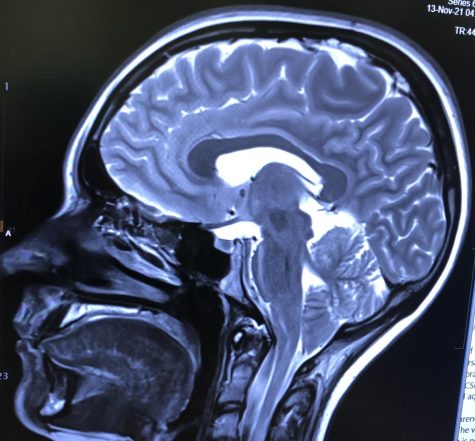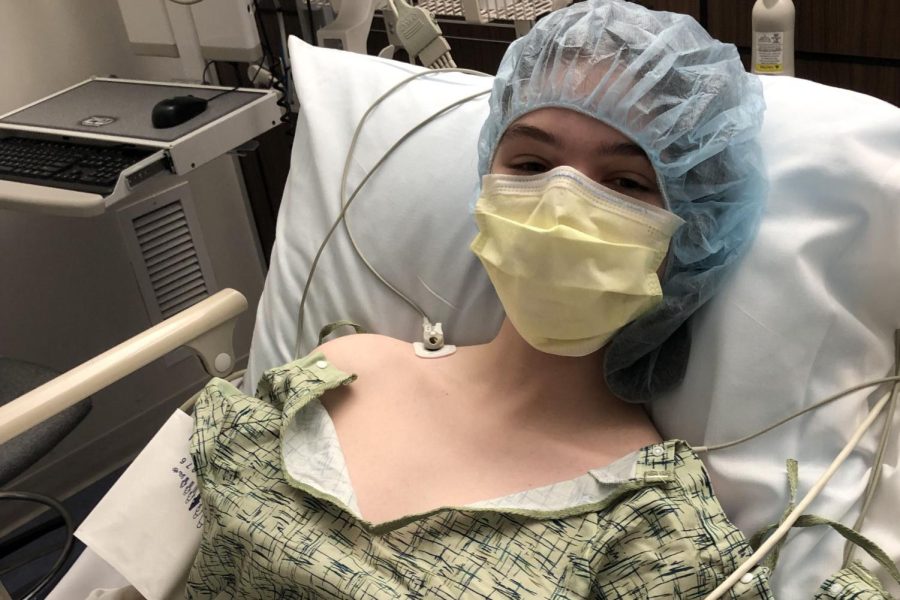Being prepared for her surgery, senior Taylor Doyle sits in the preoperative room.
Senior Taylor Doyle
During winter break, Doyle underwent brain and spinal surgery to help alleviate her chronic symptoms from Chiari Malformation. Doyle uses her experience to spread awareness about the rare illness.
While senior year is normally the time for spending the last few months with your hometown friends and soaking up the last few bits of childhood, senior Taylor Doyle spent her senior year coordinating doctors appointments and MRIs in order to plan for her brain surgery over winter break.
Taylor suffers from a hereditary condition called Chiari Malformation. Her condition caused her cerebral tonsils to hang lower than normal, which put a lot of pressure on her spinal cord and trapped the spinal fluid in her brain. This also prohibited the fluid from getting to her spine.
“I’ve had Chiari Malformation since birth, but it has gotten worse over the years. Since my freshman year, it’s gotten a lot worse until this summer where I was having symptoms increase so badly that my face and limbs started going numb,” Taylor said. “That’s when we decided that we needed to go to the neurosurgeon.”
Dr. Nancy Hammond, a neurologist at University of Kansas Health System, completed training to be recognized as an American Academy of Neurology Fellow. Hammond noted that Chiari Malformation continues to undergo studies.
“It is thought that [Chiari Malformation] is due to the back part of the skull being too small and the structures normally in the back part of the brain push out,” Hammond said. “It is suspected that there is a genetic link as it tends to run in families, and we are just starting to understand the genes involved. Chiari Malformation is a condition that is present at birth but people usually do not develop symptoms until they are teenagers or young adults.”
Taylor’s mother, Gretchen Doyle, suffered from Chiari Malformation herself until she had surgery in 2011. Gretchen found it difficult to watch her daughter suffer through the symptoms like she had years prior.
“I would say that the hardest part for Taylor would probably be her physical symptoms and how it affects her in her daily life,” Gretchen said. “Taylor has a passion to work hard and loves to be very involved with school activities. Those with chronic disorders know how hard it can be to ‘suffer in silence’ when you appear healthy to the world.”
Hammond also mentioned that the symptoms for Chiari Malformation can vary from patient to patient.
“Sometimes Chiari Malformation does not cause symptoms,” Hammond said. “Common symptoms of Chiari Malformation include dizziness, headaches and balance problems. Sometimes the Chiari Malformation can cause a spinal cord problem called a syrinx which can cause problems with muscle strength and sensation in the arms.”

Elaborating on having to “suffer in silence,” Taylor mentioned that many doctors do not know what Chiari Malformation is, which makes it difficult to receive a diagnosis.
“I was definitely blessed to have someone that had already gone through the surgery and who knows what was going on. I know a lot of people who are in the dark and just don’t know why they are having these symptoms,” Taylor said. “A lot of doctors don’t even know about Chiari Malformation. It was really nice to have my mom who understood what I was going through with my symptoms and with the surgery. My hardest part of this journey has definitely been the recovery. I basically have had to relearn how to do everything by myself. My mom had to spoon feed me for a little bit, I had to relearn how to walk, I’m still not able to drive yet and I still can’t carry or push heavy things. It’s just trying to get back to my independence.”
Gretchen noted that while Chiari Malformation did not make Taylor more susceptible for contracting COVID-19, the pandemic made it more difficult to plan Taylor’s surgery.
“COVID-19 made it more difficult to plan for Taylor’s surgery and added a layer of stress leading up to it trying to keep her well prior to the date. I am very thankful that Taylor and her brother’s teachers were so helpful and understanding and allowed some flexibility during finals week to limit our families’ exposures to illness,” Gretchen said. “A big shout-out to Ms. [Patricia] Chandler as well. She helped me to coordinate Taylor’s schedule before and after the surgery.”
Knowing how scary it can be to try to navigate an illness uncommon to the general public, Taylor hoped to spread awareness of the condition.
“I definitely want to help people who have this. I can’t even imagine what it would be like to have symptoms show up and have doctors not know for sure what was going on. I would love to be able to help people by just giving them a direction to start in,” Taylor said. “I know that before I had my surgery, I met someone online who had had the surgery just a few months before me and she helped me so much by just calming me down about having the surgery and giving me recommendations of things I would need. I would love to be that person for someone.”
Gretchen described Taylor to be resilient and thought this condition has made her stronger.
“Taylor’s young age has helped her physical resilience because she’s healed and recovered quickly. Mentally, she’s just naturally resilient and has such a passion and drive for life and so much she wants to accomplish,” Gretchen said. “One important takeaway from this whole experience is to just be kind and understanding to everyone because you never know what is going on in their life.”
